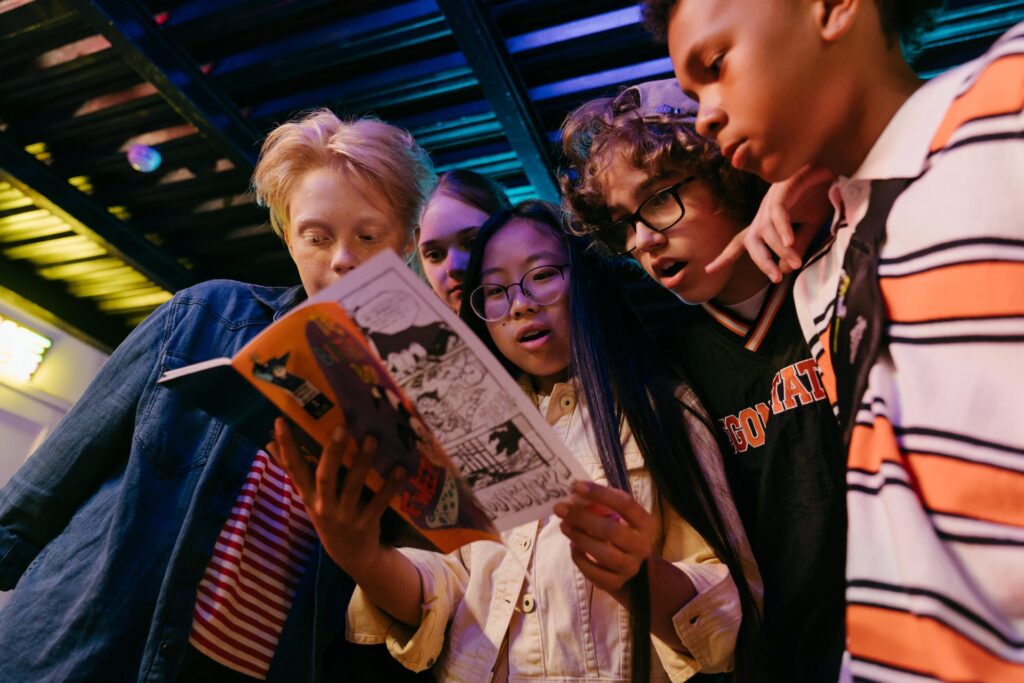Introduction
Comics, once considered a form of entertainment primarily for children and adolescents, have now found a valuable place in the realm of education. These visual narratives, often blending images with text, provide a unique and engaging approach to learning. The benefits of using comics in education are manifold, transcending age groups and subject areas. This blog explores the advantages of incorporating comics into educational settings, emphasizing their potential to enhance comprehension, foster creativity, and facilitate inclusive learning.
1. Visual Engagement
One of the most significant benefits of using comics in education is their ability to engage learners visually. Human beings are inherently visual learners, and comics tap into this fundamental aspect of our cognition. The combination of images and text not only captures the reader’s attention but also assists in creating vivid mental associations. This engagement results in improved retention and understanding of complex concepts.
For example, when teaching history, a comic can vividly depict historical events, characters, and context in a way that traditional textbooks may struggle to do. Visual narratives allow students to immerse themselves in history, making it more relatable and memorable.
2. Multimodal Learning
Comics offer a multimodal learning experience by combining visual and textual information. This diversity accommodates various learning styles, allowing students to choose the mode that best suits their preferences and strengths. Some students excel in visual comprehension, while others may favour textual information, and comics cater to both.
Moreover, they enable teachers to introduce diverse media and literary elements, such as symbolism, tone, and character development, fostering a broader understanding of literary concepts. Students can learn to analyze these elements in a more engaging manner than with traditional text-only materials.
3. Improved Comprehension and Literacy
Comics are a valuable tool in improving literacy skills. The combination of text and images encourages students to decipher both written and visual cues, thereby enhancing their comprehension skills. The visual context aids in the interpretation of difficult vocabulary and fosters the development of inference and critical thinking.
Incorporating them into language arts and literature classes allows students to explore literary devices, such as foreshadowing or symbolism, in a concrete and engaging manner.
This process deepens their literary understanding and analytical skills, ultimately leading to improved reading comprehension.
4. Fostering Creativity and Imagination
Comics are a medium that nurtures creativity and imagination. Both in reading and creating comics, students are prompted to think critically, solve problems, and imagine alternate realities. Creating their comics empowers students to express themselves artistically, encouraging them to think outside the box and explore their unique ideas.
Creative thinking is not limited to the arts; it extends to other subject areas as well. Comics can be used to depict scientific concepts, mathematical problems, and even historical debates, allowing students to explore these subjects through a creative lens.
5. Inclusivity and Accessibility
Comics promote inclusivity in education by appealing to a wide range of learners, including those with diverse learning styles and needs. Visual information reduces the language barrier, making comics accessible to English language learners and individuals with learning disabilities.
Additionally, they can be used to address complex and sensitive topics in a way that is approachable and non-threatening. For example, subjects like mental health, diversity, and cultural understanding can be explored through comics, fostering empathy and awareness in students.
6. Motivation and Engagement
The visual and narrative appeal of comics captivates students, making learning more enjoyable and motivating. When students are enthusiastic about their educational materials, they are more likely to remain focused and absorb information effectively. Comics can be a powerful tool for breaking down the barriers of boredom and disinterest that can sometimes hinder the learning process.
Conclusion
The integration of comics into education represents a powerful tool for enhancing learning across diverse subject areas. The benefits of using comics in education, including visual engagement, multimodal learning, improved comprehension, and fostering creativity, are too significant to ignore. Moreover, comics promote inclusivity and accessibility and have the potential to motivate and engage learners at all levels.
As educators and policymakers increasingly recognise the value of comics in education, it is important to continue exploring innovative ways to incorporate this medium into the curriculum. Whether through printed materials or digital platforms, comics offer a gateway to a more engaging and effective educational experience, enriching the minds of learners and nurturing their creativity and curiosity. For a wide range of comics for literary education visit Knowledge Thirst Media today.

